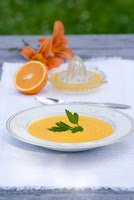
While I regularly entertain rather big groups of people at our home, I decided to play it safe this time and organise a potluck party instead, asking each local guest to contribute a dish. We did agree beforehand that the dish has to be pretty Estonian and more or less summery, and we ended up with a rather lovely spread, if I may say so myself. I think Sara and Lee agree, and I saw them at least tasting each of the numerous dishes - quite an achievement considering that they came to the party straight from the meeting with a famous local chef Dmitri Demjanov, which included a full meal at one of his restaurants.

Sara and me checking out some of the delectable dishes available.
I had invited a group of local food bloggers to the party, as well as my favourite pastry chef and good friend Heidi Park (who just happens to be an American based in Tallinn) and another good Estonian friend who currently resides in Washington DC (but is visiting home for a few weeks). The local bloggers were a mix of good foodblogging friends and some rising local foodblogging stars, and based on the quality of the dishes they brought along, I just might invite them over again soon ;)
Here's the bi-lingual menu (ignore the bottom part of the blackboard. I told you the house was full of kids ;))

On the photo below you see a beetroot salad (thank you, Mann!), a salt pork and onion flatbread, specialty on our largest island, Saaremaa (baked by Kirsike). Fried Baltic herring and a sour cream dip was brought along by Vernanda, the barley soda bread by Tuuli (I've blogged about this delicious Estonian bread here). You can get a glimpse of various local charcuterie on the left and of local artisanal cheese at the bottom. Finally, there's a selection beautiful tomatoes from our greenhouse (various cherry tomatoes - mainly Suncherry and Sungold varieties - are in a beautiful white bowl designed by a young Israeli Tal Zur of Studio Trixie), large tomatoes are next to chopped green Siberian chives, all from our garden as well:

Here's Sara taking photos of our cute tomatoes (she's a foodblogger, after all):

See that pale blue enamel pot just behind the charcuterie selection on the photo below? The pot contains a huge pile of delicious breaded and fried turkey steaks in marinade. These were made and brought along by Ragne, and it's a lighter version of this popular Estonian pork dish.

Marinated saffron milkcaps, courtesy of my K's mum:

I baked one of my favourite chantarelle quiches, flavoured with tarragon and paprika (recipe in Estonian):

Other savoury dishes included a wonderful Estonian rye bread and herby home cheese (Tuuli) and a layered smoked ham, egg and cucumber salad (Kätrin).
Sara looks happy with a glass of Estonian bubbly (see note at the end of the post), and our son is helping himself to some of the dishes:

We obviously also had quite a few sweet dishes, though in the midst of the hustle and bustle we forgot to photograph them all :) Heidi, the Tallinn-based American pastry chef, brought along a passionfruit cheesecake - a perfect balance of acidic fruit and sweet cheesecake. Kirsike made a batch of toffee-covered kama cereal balls (Estonian recipe here), and my friend Liis brought along a proper Estonian kringel (baked by her sweet diplomat husband Kristjan, who couldn't make it to the party himself), and Kätrin made a küpsisetort, a layered Estonian cookie cake (I've posted a recipe for my favourite version here).
Kaare, who drove to the party all the way from Tartu, brought along a very popular curd cheese cake - a shortcrust base, with a raisin and curd cheese topping:

Oh, and there was also a bowl of wonderful sweet-yet-tart yellow gooseberries that Triin brought along from Tartu.
Finally, I'd love to say a huge thank you to our drinks sponsors. Coffee was provided by Nami-Nami's long-time supporter Meira, who's also representing Segafredo Zanetti coffees in Estonia. Meira kindly gave us a Segafredo capsule coffee machine for the party (a huge thank you also to our barista Natalie :))
A le Coq sent us a selection of juices (plum nectar, banana-pear nectar and orange juice) and their Organic Beer (the first locally produced organic beer in Estonia)! By the way, the banana-pear nectar has two of Nami-Nami's recipes printed on each carton :):


There was another first-and-only at the party. We enjoyed chilled FEST - the first Estonian sparkling fruit wine, made from local apples. This semisweet apple wine is definitely very squaffable, if you ask me :) A huge thank goes to the producer, Põltsamaa FELIX. Another local drink company - Värska Vesi - had just re-introduced their mineral waters and still and sparkling drinking waters in beautiful glass bottles, and they kindly sent us a box of each.

All in all, I hope that Sara and her husband had great time in Estonia and that we managed to make them feel very welcome here.









































